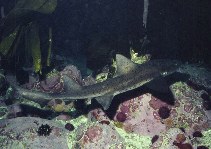| Family: |
Triakidae (Houndsharks), subfamily: Triakinae |
| Max. size: |
142 cm TL (male/unsexed); 174 cm TL (female); max.weight: 20 kg |
| Environment: |
demersal; marine; depth range 1 - 50 m |
| Distribution: |
Southeast Atlantic: Namibia to Coffee Bay, South Africa. |
| Diagnosis: |
Dorsal spines (total): 0-0; Dorsal soft rays (total): 0-0; Anal spines: 0-0; Anal soft rays: 0-0. Blunt snout and a large mouth with small pointed teeth; caudal peduncle short and heavy (Ref. 5578). Grey with numerous black spots which may be sparse or absent in some specimens; new born pups with fewer black spots compared to adults (Ref. 5485); white below (Ref. 5578). |
| Biology: |
Occurs off sandy beaches, rocky shores and in shallow bays (Ref. 5578). Feeds on crabs, lobsters, bony fish and small sharks (Ref. 5578). Ovoviviparous (Ref. 50449). Forms schools in summer (Ref. 244). Hardy and keeps well in captivity (Ref. 244). Commonly caught by rock and surf sports anglers but not eaten much (Ref. 244). Meat is dried into shark 'biltong' or jerky which commands a relatively high price (Ref. 244). Attains 160 cm, TL (Ref. 36731). |
| IUCN Red List Status: |
Least Concern (LC); Date assessed: 01 August 2019 Ref. (130435)
|
| Threat to humans: |
harmless |
Source and more info: www.fishbase.org. For personal, classroom, and other internal use only. Not for publication.
